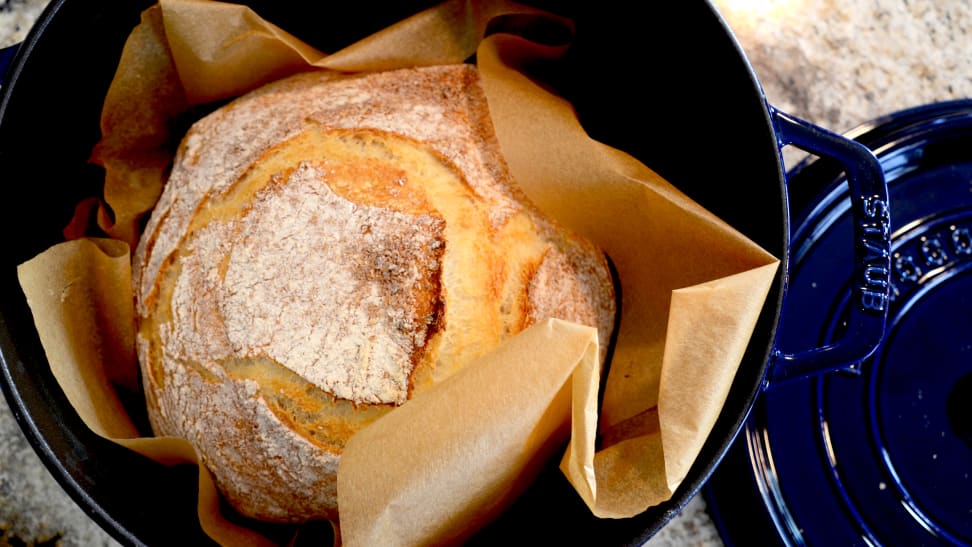 — Recommendations are independently chosen by Reviewed’s editors. Purchases you make through our links may earn us a commission.
— Recommendations are independently chosen by Reviewed’s editors. Purchases you make through our links may earn us a commission.As we all do our best to stay at home and reduce grocery runs to a minimum, we may find ourselves running out of essentials like bread. Obviously, the “easiest” solution is to make your own loaves. And you’ve probably seen friends baking up a storm on Instagram—with sourdough reigning supreme.
Making sourdough bread from scratch is a great way to learn the ins and outs of breadmaking, but it’s also time-consuming and may not be suitable for people who are just getting into baking. Waiting for the starter to mature takes about seven days, and then there’s the three-day marathon of preparation that yields just two loaves of bread. Though I do think it’s worth the effort, not everyone has the patience or resources to wait so long for some simple, crusty bread.
Thankfully, there's an alternative. With the help of some store-bought yeast, you can make delicious no-knead, no-starter bread that requires much less time and labor than traditional sourdough.
What’s the easiest way to make bread without sourdough starter?
Simply put, I use active dry yeast to build the dough and a Dutch oven to create a steamy environment for the bread to develop a fine, crusty exterior. Although this is a “no-knead” bread recipe, I still recommend doing a few rounds of “stretch and fold” if you have the time. It can really help with gluten development and therefore build more strength in the final loaf.
As I’m always experimenting with different methods from professionals, I rely heavily on tools and appliances that help me make up for my lack of technical skills. To trap the moisture that’s essential to creating a high quality loaf, my choice of cooking vessel is the Dutch oven, as its heavy lid seals the pot tightly enough to prevent the steam from escaping. Our favorite Dutch ovens from Staub and Le Creuset can seal in moisture and guarantee even heating.
Don’t have a Dutch oven? Here are a few other ways to help you create the steam necessary for a nice crust:
- Use an oven-safe large pot covered by a sheet pan as its lid. Make sure the pot has enough clearance so that it doesn’t touch the top of the oven.
- Use a cast iron skillet. Preheat the skillet with an oven-safe casserole or pan filled with water underneath to create a steam bath.
- Use a pizza stone. Preheat a pizza stone and add a casserole dish filled with water underneath. Bake the bread on the pizza stone.
Here’s how to make my no-knead artisan bread without using sourdough starter.
Recipe: No-Knead Artisan Bread (1 loaf)
What You Need
Ingredients:
- 2 ¼ tsp (9 grams) active dry yeast
- 1 tsp (4 grams) sugar
- 1 ¼ cup (300 grams) lukewarm water
- 2 ½ cups (360 grams) all purpose flour
- 1 ½ tsp (10 grams) kosher salt
Tools:
- A kitchen scale (optional)
- A Dutch oven (we used our favorite, the Staub Round Cocotte)
- One large mixing bowl or a stand mixer
- A tea towel or plastic wrap
- A bench scraper
- A proofing basket or a medium bowl
- A lame or a sharp knife
- A cooling rack
Time Needed
1 hour and 45 minutes
Difficulty
Easy
Step-by-Step:
Step 1: Activate the yeast
In a large bowl (use the mixing bowl if using a stand mixer), combine the yeast, sugar, and warm water. With a spoon or a spatula, mix the ingredients. Let sit for five minutes until the mixture becomes bubbly and foamy.
Step 2: Mix the ingredients together
In small batches, add the flour to the mixture, stirring in between. Then add the kosher salt. If you’re using a stand mixer, attach the dough hook and turn it on low. Gradually increase the speed until the dough starts to pull away from the sides of the bowl. If not using a stand mixer, use a baking spatula to mix all the ingredients until everything is well combined and dough starts to get stretchy. Dust some flour on the dough and let rest in the bowl under a damp tea towel in the bowl at room temperature for an hour (the closer to 75°F, the better).
Step 3: Stretch and fold
When the dough doubles in size, tip the bowl and carefully transfer the dough onto a thoroughly floured surface using a bench scraper. Using floured hands, pick up the corners of the dough and fold on top. Do a few folds until you can feel some resistance from the dough. Then pull the corners towards the center and seal the folds by pinching.
Step 4: Shape the dough
Dust a proofing basket or a medium bowl with flour (you can also use cornmeal, rice flour, or wheat bran). Use a bench scraper to help pick up the dough and gently lay the dough (seams side up) into the center of the basket. Dust the dough with more flour. Cover the basket with a damp towel and let rest for half an hour at room temperature (again, the closer to 75°F the better).
Step 5: Preheat the oven
As the dough rests, place the Dutch oven inside the oven and preheat to 460°F (this is my personal preference). In general, you can set the temperature between 450°F to 500°F to make bread, but it also depends on the oven. My oven takes half an hour to reach 460°F, which is how long it takes for the dough to rest in the proofing basket. If yours takes longer than that to reach the optimal temperature, then move up this step up to just after forming the dough (step 2).
Make sure the knob on the Dutch oven lid is made of metal like brass or stainless, as the plastic ones will melt. If you have a plastic knob, unscrew it before preheating and use oven mitts to handle the lid.
Step 6: Bake the bread
Tip the proofing basket and transfer the dough onto a piece of floured parchment paper with the seam side down. Use a lame (or a sharp knife) to score the dough with an “x” pattern before it goes into the oven. Lift the parchment paper by the sides and place with the dough into the preheated Dutch oven. Put the lid on and bake for 30 minutes.
Step 7: Remove the lid and finish
Remove the Dutch oven lid. By now, the bread should have developed a pale color. Let it bake for another 10 to 15 minutes without the lid until the color darkens. Remove from the oven. Let cool on a cooling rack for 10 minutes and enjoy!
This is a relatively easy bread recipe that doesn’t require a lot of hard labor. Though it may not provide as much chewiness and as many air pockets as a slice of sourdough bread, it’s still worth making—and it's a great alternative to store-bought bread. Once you get the hang of it, you can also add dried fruits, nuts, or herbs to suit your taste.
If you’re having trouble finding essential items while under quarantine, we’ve got a range of home cooking projects covered, including the perfect tortilla, pasta, and coffee drinks.
Related content
-

-

The Best Tortilla Presses of 2020best-right-now
The product experts at Reviewed have all your shopping needs covered. Follow Reviewed on Facebook, Twitter, and Instagram for the latest deals, product reviews, and more.
Prices were accurate at the time this article was published but may change over time.


